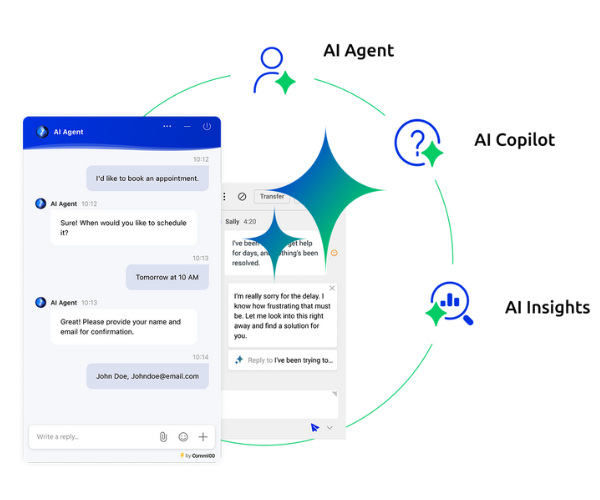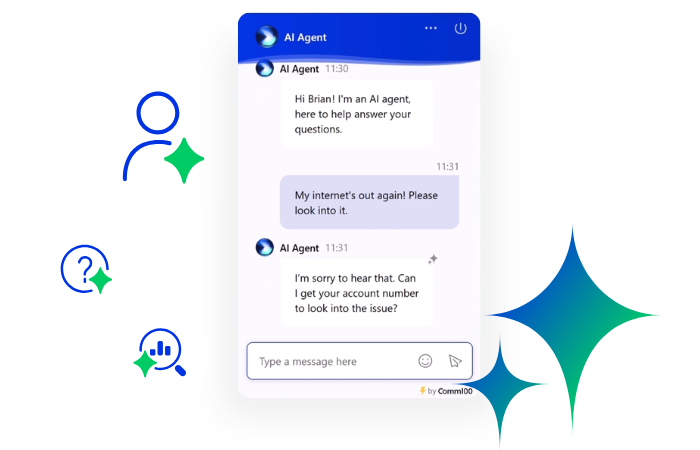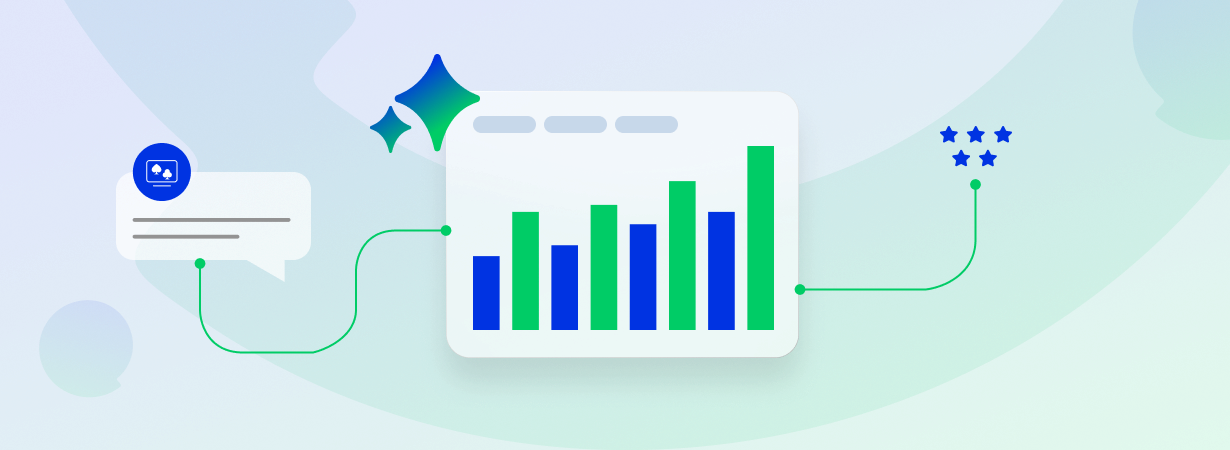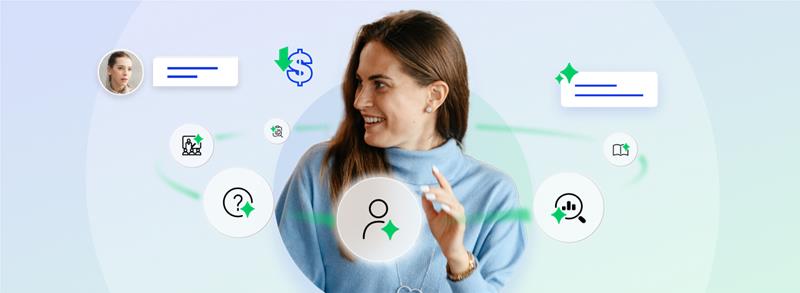It’s hard to remember a time when chatbots weren’t a hot (albeit, polarizing) topic in the customer service and tech industries. From customized chatbots on major brand websites to the recent advent of Generative AI chatbots, it seems like chatbots have entered the discussion (and our lives) for good.
There’s a reason why we’re so attracted to chatbots (or at the very least, drawn into the conversation): Chatbots promise to do many things. Articles about chatbots boast the innovation that they bring to the table and paint artificial intelligence (AI) as the future of customer service and marketing. Other articles tout the new and creative ways that chatbots are being used, such as Google’s bot that debates the meaning of life, or Domino’s Tinder Chatbot, “Dom Juan”, that feeds users cheesy one-liners to help them land a date (“I pepperonly have eyes for you!”).
As true as they may be, the glitz and glamour of these claims do little to show business owners and corporate executives how exactly chatbots can help their company. What decision makers really want to know is: Is investing in a Chatbot worth it, and how much money can Chatbots actually save?
The New Comm100 AI Trifecta – Driving Smarter, Deeper Customer Relationships
Learn how AI Agent, AI Copilot, and AI Insights work together to transform CX.
Watch the webinar
Webinar
This blog post is dedicated to helping you calculate the return on investment (ROI) that Chatbots will bring your company, and how much money Chatbots can save you.
Why Chatbots?
Before you invest in chatbots, the most important thing to know before how much, is why.
Companies across industries find the potential of chatbots attractive. CCW Digital’s Fall Executive Report reveals that 80% of organizations call artificial intelligence “important.” Sixty-one percent have plans to incorporate (or continue incorporating) AI into their customer experience.
It’s not just companies – studies show that the majority of customers already accept or even prefer chatbots. New findings in the Aspect Consumer Experience Index show that 61% of consumers feel that having chatbots in customer service is the way of the future. Seventy percent of millennials report , and many prefer chatbots for the convenience and immediate gratification.
Let’s remember that before they are glamorous, futuristic, game-changing service robots, chatbots are one simple thing: automation systems. Chatbots help businesses efficiently accomplish tasks that would have otherwise required human labor. This is important because businesses are always looking to cut costs without sacrificing service or product quality. By automating simple tasks, chatbots offer customers speeder support at a lower rate for companies.
Read more: A Comprehensive Guide to Chatbot Apps
How Can Chatbots Help Me Save?
According to one report, Chatbots currently account for business cost savings of $20 million globally. And, that number is expected to rise. Findings from analysis firm Juniper Research show that Chatbots are expected to trim business costs by more than $8 billion per year by 2022.
Here are some ways that Chatbots help businesses save:
1. Reduced Operational Costs
Chatbots are like evolved self-service portals or advanced knowledge bases. They help customers quickly and easily find the answers to simple queries. As a result, they reduce the number of incoming calls to contact centers, improving efficiency and reducing operational costs.
Incoming call volume isn’t the only things that Chatbots reduce – they also lower overall interaction volume – including chats, emails, and social media inquiries. Each time a customer interacts with a Chatbot before a live person, the cost per query gets lower. This is especially true for phone assistance. According to VentureBeat, “Even if a person makes a ‘call me’ command to connect with a live agent after initiating a Chatbot interaction, a contact center pays about 33 percent less for outbound calls than inbound calls.”
During an interaction, Chatbots can capture relevant customer information, meaning that the agent can initiate the conversation equipped with prior knowledge about the query should the customer need to be transferred. For the agent, even already knowing what the customer’s query is and what the bot has suggested shaves valuable seconds off that interaction. This means a quicker resolution for customers, a lower cost-per-interaction for companies, and better use of agents’ paid time.
2. Lower Labor Expenses
Another way that Chatbots save companies money is through reduced labor costs. According to a report by the Call Center School, 65 to 70% of a call center’s total operating costs are related to staffing.
It’s not easy to cut costs around staffing while also fulfilling customer expectations. Businesses who reduce their agent count to save money often find the number of calls and chats in their queue skyrocketing – and customer satisfaction levels taking a hit. Longer wait times equal a more expensive phone bill, meaning that cutting staff may actually end up costing more than it saves.
For companies who want to save on labor expenses, hope isn’t lost. According to research by McKinsey, 29% of customer service positions in the US could be automated through Chatbots and other currently available technology. While a live chat agent can effectively chat with about three customers at once (and a phone representative can handle only one at a time), Chatbots can handle an unlimited amount of interactions simultaneously.
A quality Chatbot often costs less than the annual salary of a single employee, even after initial installation and programming costs (consider the costs of hiring, onboarding, training, hourly pay, and benefits per agent). And, Chatbots more than pull their weight. According to our 2019 Live Chat Benchmark Report, Comm100’s Chatbot takes care of about 26.65% of all incoming live chat inquiries alone. This means that even with one less agent (or without downsizing staff at all if a company’s support requirements are growing!) Chatbots help companies reduce labor expenses and save money.
3. Cheap 24/7 Availability
What’s the point of live chat if it’s not live?
More and more customers expect companies to accommodate their schedules and deliver 24/7 customer service. This can pose a problem for businesses that don’t want to spend extra money to operate during late-night or low-traffic hours. While some enterprises have turned to cheaper international or freelance live chat teams to solve this problem, others are now investing in Chatbots.
Chatbots cost the same whether they’re available 24/7, three hundred and sixty-five days per year or not. By letting Chatbots handle after-hour queries, companies can provide customers with the support that they need – when they need it – without having to hire additional agents to cover these odd working hours.
4. ROI in Agent Happiness (and Better Allocation of Corporate Resources)
Even the most experienced agents can have their patience tested by having to answer the same question over and over from different customers. Call center work is at its least rewarding when it’s basic and repetitive, and often agents wish they could cut out these queries and focus on assisting customers with complex questions who need their help the most.
Allowing a Chatbot to handle simple, repetitive queries takes this burden off agents, and helps them to develop their skills by only taking on the queries that really test the limits of their knowledge. This leads to a happier, more fulfilling agent experience. Cultivating a quality agent experience is important to contact centers of all sizes: According to CCW Digital’s Winter Executive Report, 33% of companies agree that improving the agent experience is a top priority for 2018.
Fulfilled agents have a lower turnover rate, meaning that companies don’t have to invest as much time and resources in recruiting, hiring, training, and onboarding new agents. These costs can then be used to fund other, more important company endeavors. Happier agents are also more productive, which means that they can better achieve contact center metrics. (Just remember that if you adopt a Chatbot you’ll have to adjust your metrics a bit, to reflect the time that it takes to solve just complex queries). And, happier agents have a better overall workplace morale, which translates into the quality of customer service. As the report says, “Agents, quite simply, are the gateway to a productive, customer-centric experience.”
5. Value in Customer Satisfaction
Customer and company channel preferences don’t often align – however, AI makes that possible. Chatbots allow businesses to resolve customers’ issues on digital channels that are convenient for customers and inexpensive for companies. And customers appreciate the self-service nature of Chatbots. With Chatbots, customers don’t have to wait in a queue for an agent to assist them, and they won’t be placed on hold while an agent looks up information. Chatbots give customers frictionless support with less effort and can resolve issues as quickly as customers can type.
Customers can get upset if they don’t feel valued or respected by an agent. They like that Chatbots are objective – free from the judgment and cognitive biases that affect human communications and decision making. For example, sometimes a human agent might give incorrect advice because they’ve encountered a situation that seemed similar to one they had seen recently, when actually if they had looked at the circumstances objectively they might have made different decisions.
Agents might also let emotionality or a bad day get in the way of what they can do for a customer – Chatbots, on the other hand, don’t have that problem. As Joe Gagnon, Chief Customer Officer of Aspect Software writes, “There is a predictable and reliable component of Chatbots. They never tire, do not call in sick, and if designed correctly are consistent and exacting.”
Nearly 50% of consumers already engage in automated conversations with Chatbots. But Chatbots can also help improve the satisfaction of customers who don’t engage directly with them. When bots take care of simple queries, agents begin to become experts in handling more complex queries. They get used to using their problem-solving abilities rather than just churning out scripted responses, which means that they will be more able and willing to give customers with challenging issues quality assistance.
A recent Pelorus research survey found that 74% of contact center managers felt that improved customer service agent technology can decrease error rates and improve the customer experience. A positive customer experience makes way for more loyal customers, and more dollars spent. Just make sure to plan your Chatbot effectively so that it doesn’t end up having the opposite effect and frustrating customers with useless answers.
6. Greater Savings Over Time
A satisfying Chatbot experience can condition customers to go back for more. Once a customer has effectively resolved an issue with a Chatbot for the first time, they open up to the possibility of using the Chatbot as a go-to measure when dealing with their next issue.
The result? Fewer and fewer customers calling in as their first resolution option, and greater savings for companies over time.
Chatbots can also help companies save long-term by putting them ahead of the competition. According to an Oracle survey, 80% of large businesses plan on using Chatbots by 2020. Current Chatbot clients demonstrate that they are trailblazing with early-stage technology that is only improving, and that will definitely be a cornerstone of customer contact in years to come.
By locking into Chatbot contracts now, companies can get better rates and gain valuable user experience that will set them ahead of their competitors as this technology continues to advance over time.
7. Drive Revenue
Many businesses use Chatbot technology to generate leads and make sales. Chatbots can proactively alert customers to sales and discount opportunities, increasing upsells and engaging visitors. Chatbots on third-party messaging platforms such as Facebook Messenger can provide useful content that drives visitors to the company website. They can also offer expansive menus that present customers with options that they weren’t even thinking about when they initiated the chat – encouraging clicks and product discovery.
Chatbots can also be used for marketing. Creative bots such as Domino’s Tinder bot and Taco Bell’s Emoji Engine often get a lot of mileage on social media, helping to spread brand awareness. They can be used to make communicating with brands more personalized – and more fun.
Calculating the ROI of Chatbots
Chatbots look good on paper. Still, you shouldn’t invest in any technology – no matter how appealing – without first estimating what the ROI of that product will be.
The New Comm100 AI Trifecta – Driving Smarter, Deeper Customer Relationships
Learn how AI Agent, AI Copilot, and AI Insights work together to transform CX.
Watch the webinar
Webinar
If you want to calculator for yourself, or are interested in how we came to the calculation, take a look at the following points:
1. Identify Eligible Queries
First, examine what queries your company currently receives over live chat. Then, identify the top simple queries that could be resolved by a Chatbot. These queries could include questions about return policy, shipping times and rates, store location and other non-complicated issues. These questions may already be answered in your present knowledge base, or consist of easily available and communicable information.
Depending on your bot’s offerings, queries may also be expanded to include customer questions about personalized account information. Bots with these capabilities can give more specific responses to queries by consulting the customer’s available details. Applicable questions may include the following:
- What was the amount of my last bill?
- What is the tracking number for my order?
- What is my shipping address?
- What date will my order be delivered?
- What is my order status?
As bots grow more advanced, some may even be able to complete simple tasks for customers, such as changing passwords or billing addresses upon request.
By familiarizing yourself with a Chatbot’s present capabilities, you will be able to better categorize what sort of questions it will be able to answer. When identifying these questions, it helps to ask live chat agents for their input, since they are experts on common queries. Another way to do this is by asking agents to identify or tag eligible queries post-chat in wrap-up mode.
2. Calculate the Percentage of Chats Dealing with Eligible Queries
Once you know what questions to look out for, it’s time to calculate how many of your chats are made up of simple (what a bot could answer) vs complex queries (what an agent should answer). What percentage of your total chat volume do the Chatbot-friendly queries make up? Are they 10%? Twenty percent? Fifty percent?
The higher the number, the more your company stands to gain in operational efficiencies for the dollar value of the Chatbot.
For the sake of this example, let’s assume that your company receives 6000 chats per month. The eligible questions that you identified make up 3000 out of 6000 chats in one month, or 50%.
3. Calculate Agent Time Spent on Eligible Chats
Once you have this number, it’s time to focus on the people who are currently handling these chats: the agents. How much time do agents spend handling eligible chats daily, monthly, or yearly?
Calculate the estimated handle time for these types of simple inquiries. if your data suite is advanced enough, you might be able to tie in the simple query types taken from wrap-up data and find out the handle time totals for each of these categories.
Continuing the example above, let’s say that your agents spent 10 minutes on average on each of these 3000 chats (the average chat time is 11 minutes and 53 seconds according to our 2019 benchmark report).
4. Estimate the Annual Cost of Handling Eligible Chats
To see how much a Chatbot will save you, you have to look at what you’re currently spending. That starts with measuring the average hourly cost of a live chat agent.
Multiply the average hourly pay of your live chat agent by the number of hours spent on these kinds of interactions. Once you have done that, figure out your annual cost by multiplying your monthly cost by 12.
For example, imagine that the average hourly cost of a live chat agent at your company is $15 per hour. Multiply that by 500 hours (your time spent per month on Chatbot-friendly interactions), and you get $7,500. To get the approximate annual cost of those interactions, multiply that by 12 (months) and you get $90,000.
In this example, $90,000 is what it costs per year for your company to handle questions over live chat that a Chatbot is capable of handling on its own.
5. Time to Compare: How Does the Chatbot Stack Up?
Once you know how much your company is spending handling simple queries, it’s time to compare that annual rate to what you might spend on a Chatbot. For this part, consult a Chatbot provider on the annual fee of their Chatbot, and place the two values side-by-side.
For example, let’s say your prospective Chatbot costs $50,000 per year. In this scenario, it has clear advantages over continuing to pay $90,000. Theoretically, the $50,000 that you would spend on a Chatbot can replace one full-time agent doing that same type of query all the time (and this doesn’t even account for employee turnover and training costs).
Don’t forget that Chatbots also have their own deployment costs, which you may want to factor in as an aside when calculating your first year’s ROI.
Incoming chat counts are rising every year – from 2017 to 2018, businesses saw big increase in average chats per month, no matter what the size of their chat team is. As these numbers go up, so will the amount of easily answered chats that your Chatbot is capable of handling. And, as Chatbot providers further push the boundaries of what customer-facing AI systems are capable of, Chatbots will be able to handle increasingly complex queries. This means that even including any Chatbot development and maintenance costs, your bot will grow more profitable as the years go by.
Remember that this ROI calculation model only works if your Chatbot can solve the incoming queries that it is designed to, and not make your queue worse. To ensure proper use of your Chatbot, remember that implementation is key. Be sure to map out your Chatbot’s journey, and make use of customer feedback. By simply asking your customers to rate whether an answer was helpful or not, you and your Chatbot can make tremendous strides in learning what is working and what isn’t.
Conclusion
As companies move to embrace AI, experts are bracing for a surge in automated customer service programs. Researchers predict that within the next five years, between 75 and 90% of queries will be dealt with by Chatbots, resulting in cost savings of up to $0.70 per interaction.
While companies may have different opinions on Chatbots, they all agree on the importance of saving money. We hope that this blog post has given you some insight on how Chatbots can help your business save, and whether customer-facing AI is a good option for your business.
The New Comm100 AI Trifecta – Driving Smarter, Deeper Customer Relationships
Learn how AI Agent, AI Copilot, and AI Insights work together to transform CX.
Watch the webinar
Webinar
Note: This blog post was originally published in Feb 2018. Because it is one of our most popular posts, we have updated it to include the latest research, up-to-date statistics and best practices in this topic.







